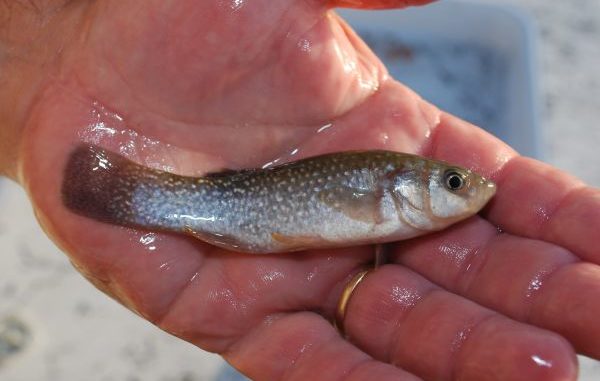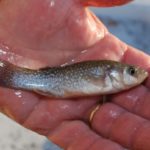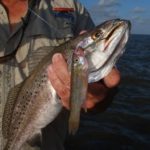
I’m not sure why fishermen in the other Gulf coast states call them bull minnows and we call them cocahoes, and I don’t have a clue what the origin of our name is — but you can bet it has something to do with our Cajun heritage.
Cocahoes are known to scientists as gulf killifish, Fundulus grandis. Both parts of the Latin name are derived from Latin. Fundulus is a dimunitive of fundus, which means “bottom.” The second part of the name, grandis, means large or full-grown.
The American Fisheries Society recognizes 50 different species in the killifish family, Cyprinodontidae. Some are called studfish or pupfish, but most of them are known as killifish or topminnows. Interestingly, 37 of them only occur in freshwater. Four species are confined to saltwater and nine, including our protagonist, are found in both freshwater and saltwater.
Cocahoes are extremely tough fish, meaning that they are found in a wide range of habitat conditions and can endure abuse in a bait well that would snuff out most other bait species.
In the wild, they can be found from freshwater marsh habitat with zero salinity to salinities as high as 76 parts per thousand (ppt). The latter number is over twice the strength of pure offshore seawater.
Obviously, though, survival means something altogether different than thriving.
A Florida study showed them living a maximum of a month in freshwater after being transferred from brackish water. Yet, in some conditions, they do survive in freshwater. Breeding populations of the fish have been established in interior rivers many miles from the coast in Texas, as well as southeastern New Mexico.
In the wild, they are also capable of surviving very low oxygen conditions and near freezing to 95 degree temperatures. Their toughness and ease of handling are the reasons that they have become the darling of researchers testing the effects of crude oil on fish.
Preferred habitats have a salinity range of 5 to 18 ppt. Also, the presence of lots of vegetation for spawning and foraging is very desirable. Research shows that when high tides flood marsh grasses, cocahoes go on feeding binges, eating far more than during normal tide cycles.
While to fisherman cocahoes look like innocent, spineless and toothless — but slimy little guys — to the other creatures in their habitat, they are aggressive terrors. They eat virtually anything.
A study done in Bay St. Louis, Miss., showed their most-important food items to be small fiddler crabs, mud snails, marine worms and small shrimp-like crustaceans (copepods, amphipods and tanaids). Other research shows them feeding on small fish, grass shrimp, insects, bottom algae and pieces of plants. Anything too large to swallow whole, they pick apart with determination.
They are also voracious consumers of mosquito larvae. For this reason they were deliberately stocked in Hawaiian waters in 1905.
By and large, cocohoe minnows are drab little fish. Females are olive on their backs shading to silver beneath. Males are more attractive, being spangled with silvery flecks, sometimes arranged in vertical bars on their sides. But spawning season brings out their best: Males develop a blue back color with blue fins spotted with light-blue spots and edged in yellow-orange.
Spawning season is March to September, perhaps October. Best spawning sites have dense beds of marsh grass or aquatic vegetation. During periods of very high tides, a ripe female, heavily courted by an amorous male, lays her sticky eggs on the now-submerged vegetation.
Unlike many fish species that broadcast hundreds of thousands of eggs to the mercy of nature, a female cocahoe lays only 10 to 20 eggs per spawn. She will spawn repeatedly during the high-tide cycle, producing about 80 eggs over the five-day high-tide period.
Stuck to vegetation above the average water level, the eggs develop in the humid atmosphere. Thirteen to 15 days later, when high tides return with the lunar cycle, the eggs hatch.
The young fish grow rapidly, becoming sexually mature between their first and second year. Wild cocahoe minnows can live to be 4 years old, but few ever see a third or fourth year. They seldom grow longer than 4 inches, and females average slightly larger than males of the same age.
The growth and spawning cycle is evident in the supply of minnows for bait, reaching its lowest level in May each year before the fish spawned the previous year grow large enough to use for bait.
Cocahoe minnows are far from the most-glamorous of bait species, and were used much less frequently in the past than now. During survey work of the cocahoe minnow fishery in 1995, Louisiana Department of Wildlife & Fisheries biologists determined that the agency had sold only eight commercial minnow-trap licenses in 1989. By 1995, the number had increased to 131, and then to 162 by 2000.
Most commercial minnow fishermen fish on a part-time basis, also commercially fishing for shrimp or crabs.
Few anglers would choose cocahoe minnows over live croakers, pogies or even shrimp. But demand is ever-growing because cocahoes are easy to keep alive and available most months of the year. Some anglers, fortunate to live in rural coastal areas trap their own, baiting traps with crushed crab. Most buy them. Increasingly, farm-raised cocohoe minnows are filling the gap between supply and demand.




